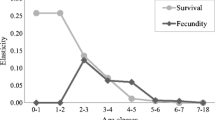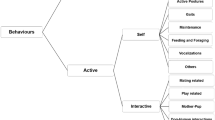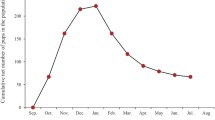Abstract
A population of urban free-ranging dogsCanis familiaris Linnaeus, 1758 was studied in Katwa, West Bengal, India. The analysis of changes in the density of the dog population over a period of 4 years revealed a considerable stability of this population. Mean (±SD)2 seasonal population density was 185±19 dogs/km2, ranging from 156 to 214 dogs/km2. A sex ratio of 1.37∶1 in favour of male was recorded in this study. High mortality (67%) occurred under the age of 4 months, and 82% mortality occurred within the age of 1 year. Among the adults, 24% mortality under the age of 2.6 year was recorded. Only a single breeding cycle and synchronization of breeding was observed. Immigration was observed as a crucial factor affecting the stability of this population.
Similar content being viewed by others
References
Beck A. M. 1971. The life and times of shag, a feral dog in Baltimore. Natural History 84: 58–65.
Beck A. M. 1973. The ecology of stray dogs: a study of free-ranging urban animals. York Press, Baltimore: 1–98.
Beck A. M. 1975. The ecology of ‘feral’ and free-ranging dogs in Baltimore. [In: The wild canids: Their systematics, behavioural ecology and evolution. M. W. Fox, ed]. Van Nostrand Reinhold, New York: 380–390.
Bekoff M. 1977. Mammalian dispersal and the ontogeny of individual behavioural phenotypes. The American Naturalist 111: 715–732.
Bekoff M. 1979. Scent-marking by domestic dogs. Biology of Behaviour 4: 123–139.
Berman M. and Dunbar I. 1983. The social behaviour of free-ranging suburban dogs. Applied Animal Ethology 10: 5–17.
Boitani L., Francisci F., Ciucci P. and Andreoli G. 1995. Population biology and ecology of feral dogs in Central Italy. [In: The domestic dog: Its evolution, behaviour and interactions with people. J. Serpell, ed]. Cambridge University Press, New York: 217–244.
Boitani L. and Racana A. 1984. Indagine eco-etologica sulla popolazione di cani domestici e randagi di due comuni della Basilicata. Silva Lucana, Bari 3: 1–86.
Causey M. K. and Cude C. A. 1980. Feral dog and white tailed deer interactions in Alabama. The Journal of Wildlife Management 44: 481–484.
Daniels T. J. 1983. The social organization of free-ranging urban dogs. 1: non-estrous social behaviour. Applied Animal Ethology 10: 341–361.
Daniels T. J. and Bekoff M. 1989. Population and social biology of free-ranging dogs,Canis familiaris. Journal of Mammalogy 70: 754–762.
Davis D. E. and Winstead R. L. 1980. Estimating the numbers of wildlife populations. [In: Wildlife management techniques manual (4th ed.). S. D. Schemnitz, ed]. The Wildlife Society, Washington: 221–245.
Font E. 1987. Spacing and social organization: Urban stray dogs revisited. Applied Animal Behaviour Science 17: 319–328.
Fox M. W. 1978. The dog: Its domestication and behaviour. Garland STMP Press, New York: 1–296.
Ghosh B., Choudhuri D. K. and Pal B. 1984. Some aspects of the sexual behaviour of stray dogs,Canis familiaris. Applied Animal Behaviour Science 13: 113–127.
Jones E. and Stevens P. L. 1988. Reproduction in wild canids,Canis familiaris from the eastern highlands of Victoria. Australian Wildlife Research 15: 385–394.
Kirk R. W. 1977. Current veterinary therapy. [In: Small animal practice. Vol. VI. W. B. Saunders, ed]. Philadelphia: 1–1418.
Kleiman D. G. 1968. Reproduction in the Canidae. International Zoo Yearbook 8: 1–7.
Kleiman D. G. and Eisenberg J. F. 1973. Comparisons of canid and felid social systems from an evolutionary perspectives. Animal Behaviour 21: 637–659.
Macdonald D. W. and Carr G. M. 1995. Variation in the dog society: Between resource dispersion and social flux. [In: The domestic dog: Its evolution, behaviour and interactions with people. J. Serpell, ed]. Cambridge University Press, New York: 199–216.
Nakada A., Fujita T. and Sato H. 1996. A case study of home range and habitat use in 3 free-ranging dogs: Effects of past histories. Journal of Ethology 14: 139–143.
Nesbitt W. H. 1975. Ecology of a feral dog pack on a wildlife refuge. [In: The wild canids: Their systematics, behavioural ecology and evolution. M. W. Fox, ed]. Van Nostrand Reinhold, New York: 391–396.
Oppenheimer E. C. and Oppenheimer J. R. 1975. Certain behavioural features in the pariah dog,Canis familiaris in West Bengal. Applied Animal Ethology 2: 81–92.
Pal S. K. 1999a. Some aspects of ecology and behaviour of free-ranging urban dogs,Canis familiaris. Ph D thesis, Burdwan University, Burdwan: 1–125.
Pal S. K. 1999b. Reproduction in free-ranging dogs,Canis familiaris in West Bengal, India. XXVI International Ethological Conference, Bangalore 1999: 171.
Pal S. K., Ghosh B. and Roy S. 1998a. Agonistic behaviour of free-ranging dogs,Canis familiaris in relation to season, sex and age. Applied Animal Behaviour Science 59: 331–348.
Pal S. K., Ghosh B. and Roy S. 1998b. Dispersal behaviour of free-ranging dogs,Canis familiaris in relation to age, sex, season and dispersal distance. Applied Animal Behaviour Science 61: 123–132.
Pal S. K., Ghosh B. and Roy S. 1999. Inter- and intro- sexual behaviour of free-ranging dogs,Canis familiaris. Applied Animal Behaviour Science 62: 267–278.
Rubin H. D. and Beck A. M. 1982. Ecological behaviour of free-ranging urban pet dogs. Applied Animal Ethology 8: 161–168.
Saunders G., White C. L., Harris S. and Rainier J. M. V. 1993. Urban foxes (Vulpes vulpes): food acquisition, time and energy budgeting of a generalized predator. Symposia of the Zoological Society of London 65: 215–234.
Scott M. D. and Causey K. 1973. Ecology of feral dogs in Alabama. The Journal of Wildlife Management 17: 253–265.
Voigt D. R. and Macdonald D. W. 1984. Variation in the spatial and social behaviour of the red fox,Vulpes vulpes. Acta Zoologica Fenica 171: 261–265.
Westbrook W. and Allen R. 1979. Animal field research. [In: The handbook of animal welfare. R. D. Allen and W. H. Westbrook, eds]. Garland STMP Press, New York: 148–167.
Author information
Authors and Affiliations
Rights and permissions
About this article
Cite this article
Pal, S.K. Population ecology of free-ranging urban dogs in West Bengal, India. Acta Theriol 46, 69–78 (2001). https://doi.org/10.1007/BF03192418
Received:
Accepted:
Issue Date:
DOI: https://doi.org/10.1007/BF03192418




